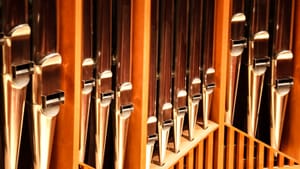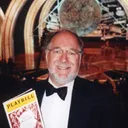Stay in the Loop
BSR publishes on a weekly schedule, with an email newsletter every Wednesday and Thursday morning. There’s no paywall, and subscribing is always free.
Some set of pipes!
The Philadelphia Orchestra with organist Paul Jacobs (first review)

To celebrate the 10th anniversary of Verizon Hall’s huge Fred J. Cooper Memorial Organ, Yannick Nézet-Séguin led the Philadelphia Orchestra in the world premiere of Christopher Rouse’s Organ Concerto with Paul Jacobs as soloist. They paired this piece with a similar work, Samuel Barber’s Toccata festiva for organ and orchestra, which was premiered by Eugene Ormandy and the Philadelphia Orchestra at the Academy of Music in 1960.
An unsound decision
Mary Louise Curtis Bok Zimbalist, heiress of the Curtis Publishing fortune, that year paid for an Aeolian-Skinner portable instrument said to be "the finest ever installed in an American music hall." It had 4102 pipes and was the world's largest portable pipe organ, made to be wheeled on and off stage. To support its great weight, concrete was poured under the stage, filling a space that previously had been left hollow.
The Academy was constructed in the 1850s over an inverted parabolic brick wall against the soil, then a hollow space, then a wooden floor of slightly convex form to radiate the sound. After the concrete pouring in 1960, the orchestra's sound never was reflected properly.
Before 1960, the Academy of Music was revered for its gorgeous acoustics. Bernard Holland in the New York Times of April 6, 2003, advanced what he called the "plausible if perverse theory" that the great Philadelphia Orchestra sound developed because musicians struggled "over several generations to hear beautiful sounds within themselves while playing in the Academy of Music's deathly dullness."
Or was it?
This is a theory unsupported by the facts. When I interviewed dozens of orchestral players for a 1969 radio documentary, they spoke in detail about their special sound. In a hundred hours of conversations, no one complained about dry acoustics, and international experts complimented the Academy’s previous fine sound.
Barber’s composition, through no fault of his, will forever be linked with the destruction of the Academy of Music’s acoustics.
The flashy Toccata Festiva received an effervescent presentation by Nézet-Séguin and Jacobs. Then they surpassed it with the rousing (pardon the pun) Rouse premiere. It starts loud, and boldly projects the varied colors of the instrument and the orchestra as Barber did but at greater length, and with a more modern vocabulary of harmonics and instrumentation. A lovely, slow, central movement was flanked by two faster, punchy movements.
The Kimmel Center’s 6938-pipe organ is built in, not portable, though it uses two separate consoles. One is in a niche above the stage and resembles British cathedrals in its vertical layout. Another is a horizontal, French desk-style console that was wheeled on-stage for both compositions. Jacobs’s solo was hymnal in the middle and triumphant in the finale. Contrabassoonist Holly Blake played a gorgeous solo.
A joyful noise
After intermission came Saint-Saëns’s Symphony No. 3, labeled "avec orgue" (with organ). This is really an orchestral work with organ accompaniment; “the king of instruments” doesn’t enter until seven minutes in, and then it remains almost inaudible, in its lowest register. Jacobs, now seated in his upper perch, added to the majestic finale with swelling fortissimo passages.
Nézet-Séguin led a detailed and atmospheric rendition — the best playing of this work I’ve ever heard. Saint-Saëns was a highly skilled composer, who constructed this old-fashioned symphony ingeniously, using counterpoint and other minute intricacies. He used the Gregorian "Dies Irae" melody and developed it with orchestration that resembles Cesar Franck’s Symphony with its scampering winds and tremulous strings. There’s colorful instrumentation and momentum — the only thing lacking is a good melody. Instead we get slow climbs up the scale and down again in slow progressions. At last, near its end, this piece comes to an exultant climax.
Jacobs played Charles-Marie Widor’s virtuosic Toccata as an encore while the orchestra players looked up at him with awed expressions.
Verizon Hall has brighter sound than today’s Academy of Music, although musicians complain they have trouble hearing each other. But the sounds of this organ are terrific, without reservation. They are most stupendous from the upper balconies, directly in front of those massive pipes.
For Linda Holt's review of this show, click here.
What, When, Where
The Philadelphia Orchestra. Paul Jacobs organ. Yannick Nézet-Séguin, music director. Barber, Toccata Festiva; Rouse, Organ Concerto; Saint-Saëns, Symphony No. 3 in C minor “with organ." November 17-19, 2016 at the Kimmel Center for the Performing Arts, 300 S. Broad Street, Philadelphia. (215) 893-1999 or philorch.org.
Sign up for our newsletter
All of the week's new articles, all in one place. Sign up for the free weekly BSR newsletters, and don't miss a conversation.
 Steve Cohen
Steve Cohen